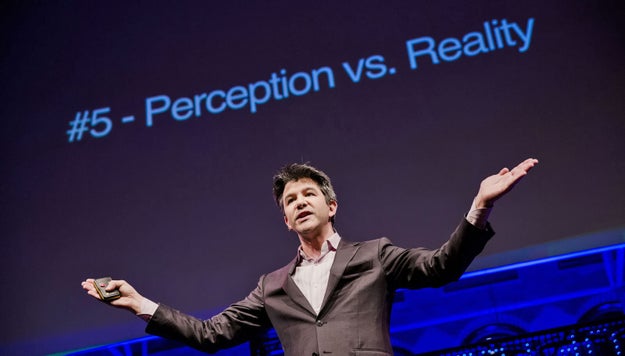Elon Musk Slams Union Drive At Tesla Factory

Tesla CEO Elon Musk listens as President-elect Donald Trump speaks during a meeting with technology industry leaders at Trump Tower in New York, Wednesday, Dec. 14, 2016. (AP Photo/Evan Vucci)
Evan Vucci / AP
In a lengthy Thursday night email to Tesla employees, CEO Elon Musk defended his record as an employer, and appealed to workers not to join the United Auto Workers union.
In the message, first leaked to Electrek.co and later obtained in full by BuzzFeed News, Musk took direct aim at claims made earlier this month in a Medium post by factory worker Jose Moran. Moran alleged that long hours of physical labor once forced six of his eight team members to take medical leave simultaneously. Musk disputed this allegation, claiming a Tesla investigation has proven it to be false. “After looking into this claim, not only was it untrue for this individual’s team, it was untrue for any of the hundreds of teams in the factory,” he wrote.
“The forces arrayed against us are many and incredibly powerful. This is David vs Goliath if David were six inches tall!”
The Tesla CEO also lambasted the efforts of the United Auto Workers union to unionize Tesla employees at the company's Fremont, CA factory, calling the organization&039;s tactics for doing so “disingenuous or outright false.” Musk alleged that the UAW&039;s “true allegiance is to the giant car companies, where the money they take from employees in dues is vastly more than they could ever make from Tesla.”
“The forces arrayed against us are many and incredibly powerful,” Musk wrote. “This is David vs Goliath if David were six inches tall&033; Only by being smarter, faster and working well as a tightly integrated team do we have any chance of success.”
Moran&039;s post — which was later followed by a press conference and a Facebook video — detailed how low pay, long hours, and difficult working conditions are making life difficult for Tesla employees. Moran argued that unionizing would improve the factory workers&039; situation.
Musk immediately swung back at Moran, telling Gizmodo that he was a union plant; earlier this week, during a Tesla earnings call, Musk told investors that the unionization “isn&039;t likely to occur.”
Moran denied Musk&039;s claims that he&039;s paid by the UAW to lead unionization efforts. His communications team, Storefront Political, declined comment on Musk&039;s email.
Musk&039;s email includes a point-by-point rebuttal of a number of Moran&039;s claims. Regarding long hours, Musk said overtime has actually decreased by 50% in the last year, and that the average employee worked 43 hours a week. Regarding compensation, he noted that Tesla factory workers earn equity, and therefore, over a four year period, earned “between $70,000 and $100,000 more in total compensation than the employees at other US auto companies.” On issues of safety, Musk said Tesla&039;s incident rate is less than half the industry average, and noted that the goal is to be “as close to zero injuries as possible.”
“There will also be little things that come along like free frozen yogurt stands scattered around the factory.”
In addition to defending Tesla&039;s record as an employer, Musk told workers that he plans to improve life at the Tesla factory, which is currently in the process of switching over its lines for production of the Model 3. For example, when the Model 3 reaches “volume production,” Musk said he&039;ll throw them “a really amazing party.”
“There will also be little things that come along like free frozen yogurt stands scattered around the factory and my personal favorite: a Tesla electric pod car roller coaster (with an optional loop the loop route, of course&033;) that will allow fast and fun travel throughout our Fremont campus, dipping in and out of the factory and connecting all the parking lots,” Musk wrote. “It’s going to get crazy good.”
Tesla declined comment. The full text of Musk&039;s email is below.
If you have information on working conditions or unionization efforts at Tesla, please contact the author directly, or tip us anonymously via contact.buzzfeed.com.
For Tesla to become and remain one of the great companies of the 21st century, we must have an environment that is as safe, fair and fun as possible. It is incredibly important to me that you look forward to coming to work every day. For that, we must be a fair and just company – the only kind worth creating.
This is vital to succeed in our mission to accelerate the advent of a clean, sustainable energy future. The forces arrayed against us are many and incredibly powerful. This is David vs Goliath if David were six inches tall&033; Only by being smarter, faster and working well as a tightly integrated team do we have any chance of success. We should never forget the history of car startups originating in the United States: dozens have gone bankrupt and only two, Tesla and Ford, have not. Despite the odds being strongly against us, my faith in you is why I am confident that we will succeed.
That is why I was so distraught when I read the recent blog post promoting the UAW, which does not share our mission and whose true allegiance is to the giant car companies, where the money they take from employees in dues is vastly more than they could ever make from Tesla.
The tactics they have resorted to are disingenuous or outright false. I will address their underhanded attacks below. While this discussion focuses on Fremont, these same principles apply to every Tesla facility worldwide.
Safety First
The workplace issue that comes before any other is safety. If you do not have your health, then nothing else matters. Simply due to size and bad luck, there will always be some injuries in a company with over 30,000 employees, but our goal is simple: to have as close to zero injuries as possible and be the safest factory in the auto industry by far. The Tesla executive team and I are absolutely committed to this goal.
That is why I was particularly troubled by the safety claim in last week’s blog post, which said: “A few months ago, six out of eight people in my work team were out on medical leave at the same time due to various work-related injuries. I hear the ergonomics are even more severe in other areas of the factory.”
Obviously, this cannot be true: if three quarters of his team suddenly went on medical leave, we would not be able to operate that part of the factory. Furthermore, if things were really even worse in other departments, that would mean something like 80% or more of the factory would be out on injury, production would drop to virtually nothing and the parking lot would be almost empty. As you know firsthand, we have the *opposite* problem – there is never enough room to park&033; In fact, we are working at top speed to build more parking. Also, hopefully our darn BART train station will open before all hell freezes over&033;
After looking into this claim, not only was it untrue for this individual’s team, it was untrue for any of the hundreds of teams in the factory.
That said, reducing excess overtime and improving safety are extremely important. This is why we hired thousands of additional team members to create a third shift, which has reduced the burden on everyone. Moreover, since the beginning of Tesla production at Fremont five years ago, there have been dedicated health and safety experts covering the factory and we hold regular safety meetings with operations leaders. Since the majority of the injuries in the factory are ergonomic in nature, we have an ergonomics department focused exclusively on this issue.
The net result is that since January 1st, our total recordable incident rate (TRIR) is under 3.3, which is less than half the industry average of 6.7.
Of course, the goal is to have as close to zero injuries as humanly possible, so we need to keep improving. If you have a safety concern or an idea on how to make things better, please let your manager, safety representative or HR partner know. You can also send an anonymous note through the Integrity Hotline (this applies broadly to any problems you notice at our company) or you can email.
Compensation
At Tesla, we believe it is important for everyone to be an owner of the company. This is your company. That is why, unlike other car companies, everyone is awarded shares and you get to buy stock at a discount compared to the public through the employee stock purchase program. Last year, stock equity grants were increased significantly and it will happen again later this year once Model 3 achieves high volume.
The chart below contrasts the total comp received by a Tesla production team member who started on January 1, 2013 against the total comp received over the same period at GM, Ford, and Fiat Chrysler. A four year period is used because that’s the vesting length of a new hire equity grant. I believe the equity gain over the next four years will be similar. As shown below, a Tesla team member earned between $70,000 and $100,000 more in total compensation than the employees at other US auto companies&033;
Work Hours
Another issue raised in the UAW blog was hours worked. First, I want to recognize how hard you worked to make our company successful. Those hours mattered to you, to your family and to our company, and I can’t tell you how much I appreciate them.
However, the pace needs to be sustainable. This is why the third shift was established and why we created alternate work schedules based on feedback from various teams in the factory.
These changes have had a big impact. The average amount of hours worked by production team members this year is about 43 hours per week. The percentage of overtime hours has declined by almost 50% since the super tough time we had last year achieving rate on the Model X, which is probably the hardest car to build in history. What an amazing accomplishment&033; It is also a lesson learned, which is why Model 3 is designed to be dramatically easier to manufacture.
Fun
As we get closer to being a profitable company, we will be able to afford more and more fun things. For example, as I mentioned at the last company talk, we are going to hold a really amazing party once Model 3 reaches volume production later this year. There will also be little things that come along like free frozen yogurt stands scattered around the factory and my personal favorite: a Tesla electric pod car roller coaster (with an optional loop the loop route, of course&033;) that will allow fast and fun travel throughout our Fremont campus, dipping in and out of the factory and connecting all the parking lots. It’s going to get crazy good
Thanks again for all your effort and I look forward to working alongside you to create an amazing future&033;
Elon
Quelle: <a href="Elon Musk Slams Union Drive At Tesla Factory“>BuzzFeed











